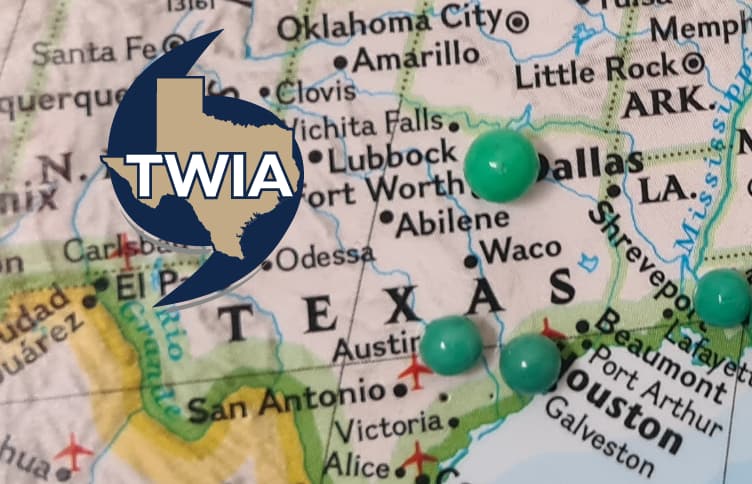TWIA reinsurance rate-on-line hits 9.6% as it seeks to control risk transfer expense

The Texas Windstorm Insurance Association (TWIA) saw the overall rate-on-line across its reinsurance and catastrophe bond program that is in-force for the 2024 into 2025 period rise to 9.6% and as risk transfer comes with higher costs attached, the insurer of last resort is looking to options to help manage that expense.
TWIA’s property exposure has been rising in recent years, which has driven an increasing need for funding to cover its statutory 1-in-100 year probable maximum loss (PML), that has come with added cost in the harder reinsurance marketplace.
TWIA’s statutory funding is made up of a range of financing sources, namely its catastrophe reserve trust fund (CRTF), a range of public securities issuances and member assessments.
For 2024, that provides some $2.45 billion in statutory funding, but the 1-in-100 year PML meant TWIA needed to fund itself up to $6.5 billion.
Which is where catastrophe bonds and traditional reinsurance limit comes in and over the course of its cat bond and reinsurance renewals in recent months, as well as with the multi-year cover from prior year cat bonds, TWIA eventually secured just over $4 billion of protection.
For comparison, the funding level rose from $4.5 billion for 2023, to $6.5 billion for 2024, driving this need for much more risk transfer.
TWIA’s 2023 reinsurance program consisted of $2.24 billion of reinsurance limit, with TWIA’s catastrophe bonds making up the biggest share at $1.2 billion, the rest being traditional reinsurance.
For the 2024 reinsurance program, TWIA secured just over $4 billion of reinsurance protection, with catastrophe bonds contributing $2.1 billion of that total and traditional reinsurance $1.95 billion.
TWIA’s Board will hear in the coming days that the $4.05 billion in reinsurance and cat bond risk transfer resulted in gross ceded premiums of $389.9 million this year, compared to a budgeted estimate of $298 million.
It reflects an overall rate-on-line (ROL) of 9.6% for the 2024 risk transfer program, compared to the 9.1% ROL for last years reinsurance and cat bond arrangements.
TWIA further said that the net cost of the reinsurance program after ceding commission was $379.4 million.
The reason TWIA needed so much reinsurance protection this year is driven by policy count and insured value exposure growth.
Since June 30th 2023, TWIA’s policy count has risen 10.9% to 262,740, but over the same period exposure in-force grew by a faster 22.4% to over $105.5 billion, reflecting the growing exposure values and inflation effects that have been widely felt across US property insurance marketplaces.
Policy count growth has slowed somewhat, but total insured values continue to rise, meaning without action there would be every chance the Texas Windstorm Insurance Association (TWIA) could find itself needing even more risk transfer next year and having to purchase more limit across its cat bond and reinsurance program.
Which is why, as part of preparing its biennial report to the Texas legislature, the TWIA staff are exploring options that could result in less reinsurance being required.
Options to reduce TWIA’s reliance on reinsurance are set to be presented in the report, with a focus on increasing the statutory funding sources to effectively lift up the attachment of the private market reinsurance risk transfer, ultimately with the hope of needing to buy comparatively less in future years.
TWIA expects to continue growing and as a result so too will the PML it needs to protect itself up to, so leveraging funding by all means to provide for the most cost-effective solution is the goal, it seems.
Depending on growth, this means the limit required from cat bonds and reinsurance may not change significantly, but the desire would be to make this a lesser proportion of TWIA’s overall funding requirements.
At the moment funding from the statutory sources of from public securities and assessments is relatively fixed, so possible solutions are mooted including adjusting the statutory funding in line with changes in TWIA exposures, utilising a mechanism to maintain the CRTF at a minimum level, as well as identifying ways the CRTF could be boosted in size, and perhaps even requiring TWIA’s premium and maintenance taxes to be deposited directly into that catastrophe reserve trust fund which could significantly increase its size.
Another way TWIA can control its exposure is through depopulation and this is also a topic being discussed.
Proposals have received mixed responses, with the Insurance Council of Texas calling for assessments to remain untouched, while the Reinsurance Association of America (RAA) said that bolstering the CRTF to reduce the amount of reinsurance needed would be a solution it might support.
No matter what measures are ultimately implemented, which could take time as it would need legislative approval, it seems TWIA’s use of reinsurance and likely catastrophe bonds would remain significant.
Especially given the expectation of continued policy count and exposure growth, meaning TWIA will continue to need the support of reinsurance and capital markets to meet its statutory 1-in-100 PML funding goal each year.
TWIA has been directly sponsoring catastrophe bonds since 2014 and now sits as one of the largest sponsors in our cat bond market sponsors leaderboard.
You can read about all of TWIA’s Alamo Re catastrophe bonds it has ever sponsored in the Artemis Deal Directory.






